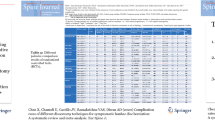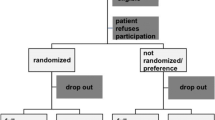Abstract
A retrospective analysis of long-term follow-up results more than 10 years after a standard nucleotomy for lumbar disc herniation with the Love method was done to determine the effectiveness of this procedure. Nucleotomy according to Love was the standard treatment for lumbar disc herniation before the various minimally invasive alternatives were recently introduced. Without long-term follow-up analysis of Love operations, evidence-based evaluation of those new methods is impossible. We believe that the standard nucleotomy procedure should now be evaluated precisely. In this study we present a comparison of 1-year follow-up results to the results more than 10 years after lumbar nucleotomy. Seventy-six consecutive patients who had undergone lumbar nucleotomy were identified. It was possible to assess 54 (71.1%) of the cases more than 10 years after surgery. The initial and final outcomes were assessed using the MacNab classification and the Japanese Orthopaedic Association (JOA) score. With the MacNab classification a successful outcome 1 year after surgery was achieved in 87.0% of the cases. At the final follow-up, this result was reduced to 74.1%. Seven patients required a second operation and patients under 21 years of age were at risk for reoperation. Patient overall satisfaction with the results of the standard nucleotomy was high. The disc height of the operation site significantly decreased after surgery; nevertheless, this did not affect the clinical outcome. A standard lumbar nucleotomy according to Love is a safe and reliable method of treating selected patients with lumbar disc herniations.
Similar content being viewed by others
References
Bostman OM (1993) Body mass index and height in patients requiring surgery for lumbar intervertebral disc herniation. Spine 18:851–854
Botsford JA (1995) The role of radiology in percutaneous laser disc decompression. J Clin Laser Med Surg 13:173–186
Davis RA (1994) A long-term outcome analysis of 984 surgically treated herniated lumbar discs. J Neurosurg 80:415–421
Dvorak J, Valach L, Fuhrimann P, Heim E (1988) The outcome of surgery for lumbar disc herniation. II. A 4–17 years’ follow-up with emphasis on psychosocial aspect. Spine 13:1423–1427
Ebeling U, Kalbarcyk H, Reulen HJ (1989) Microsurgical reoperation following lumbar disc surgery. Timing, surgical findings, and outcome in 92 patients. J Neurosurg 70:397–404
Epstein NE (1999) Laser-assisted diskectomy performed by an internist resulting in cauda equina syndrome. J Spinal Disord 12:77-79
Findlay GF, Hall BI, Musa BS, Oliveira MD, Fear SC (1998) A 10-year follow-up of the outcome of lumbar microdiscectomy. Spine 23:1168–1171
Heliovaara M (1987) Body height, obesity, and risk of herniated lumbar intervertebral disc. Spine 12:469–472
Herron LD, Turner J (1985) Patient selection for lumbar laminectomy and discectomy with a revised objective rating system. Clin Orthop 199:145–152
Hirabayashi S, Kumano K, Ogawa Y, Aota Y, Maehiro S (1993) Microdiscectomy and second operation for lumbar disc herniation. Spine 18:2206–2211
Ikeda T, Nakamura T, Kikuchi T, Umeda S, Senda H, Takagi K (1996) Pathomechanism of spontaneous regression of the herniated lumbar disc: histologic and immunohistochemical study. J Spinal Disord 9:136–140
Japanese Orthopedic Association (1986) Criteria on the evaluation of the treatment of low back pain (in Japanese). J Jpn Orthop Assoc 60:391–394
Kambin P, O’Brien E, Zhou L, Schaffer JL (1998) Arthroscopic microdiscectomy and selective fragmentectomy. Clin Orthop 347:150–167
Love JG (1959) Removal of protruded intervertebral discs with laminectomy. Proc Mayo Clin 14:800–805
MacNab I (1971) Negative disc exploration. An analysis of the causes of nerve-root involvement in sixty-eight patients. J Bone Joint Surg Am 53:891–903
Padua R, Padua S, Romanini E, Padua L, de Santis E (1999) Ten- to 15-year outcome of surgery for lumbar disc herniation: radiographic instability and clinical findings. Eur Spine J 8:70–74
Postacchini F, Lami R, Pugliese O (1988) Familial predisposition to discogenic low-back pain. An epidemiologic and immunogenetic study. Spine 13:1403–1406
Regan JJ, Yuan H, McAfee PC (1999) Laparoscopic fusion of the lumbar spine: minimally invasive spine surgery. A prospective multicenter study evaluating open and laparoscopic lumbar fusion. Spine 24:402–411
Silvers HR (1988) Microsurgical versus standard lumbar discectomy. Neurosurgery 22:837–841
Sortland O, Kleppe H, Aandahl M, Blikra G (1996) Percutaneous lumbar discectomy. Technique and clinical result. Acta Radiol 37:85–90
Spengler DM, Freeman CW (1979) Patient selection for lumbar discectomy. An objective approach. Spine 4:129–134
Sterm MB (1989) Early experience with percutaneous lateral disectomy. Clin Orthop 238:50–55
Tibrewal SB, Pearcy MJ (1985) Lumbar intervertebral disc heights in normal subjects and patients with disc herniation. Spine 10:452–454
Tonelli L, Falasca A, Argentieri C, Andreoli M, Merli GA (1983) Influence of psychic distress on short-term outcome of lumbar disc surgery. J Neurosurg Sci 27:237–240
Tullberg T, Isacson J, Weidenhielm L (1993) Does microscopic removal of lumbar disc herniation lead to better results than the standard procedure? Results of a one-year randomized study. Spine 18:24–27
Varlotta GP, Brown MD, Kelsey JL, Golden AL (1991) Familial predisposition for herniation of a lumbar disc in patients who are less than twenty-one years old. J Bone Joint Surg Am 73:124–128
Weber H (1994) The natural history of disc herniation and the influence of intervention. Spine 19:2234–2238
Author information
Authors and Affiliations
Corresponding author
Rights and permissions
About this article
Cite this article
Saruhashi, Y., Mori, K., Katsuura, A. et al. Evaluation of standard nucleotomy for lumbar disc herniation using the Love method: results of follow-up studies after more than 10 years. Eur Spine J 13, 626–630 (2004). https://doi.org/10.1007/s00586-004-0690-8
Received:
Revised:
Accepted:
Published:
Issue Date:
DOI: https://doi.org/10.1007/s00586-004-0690-8




